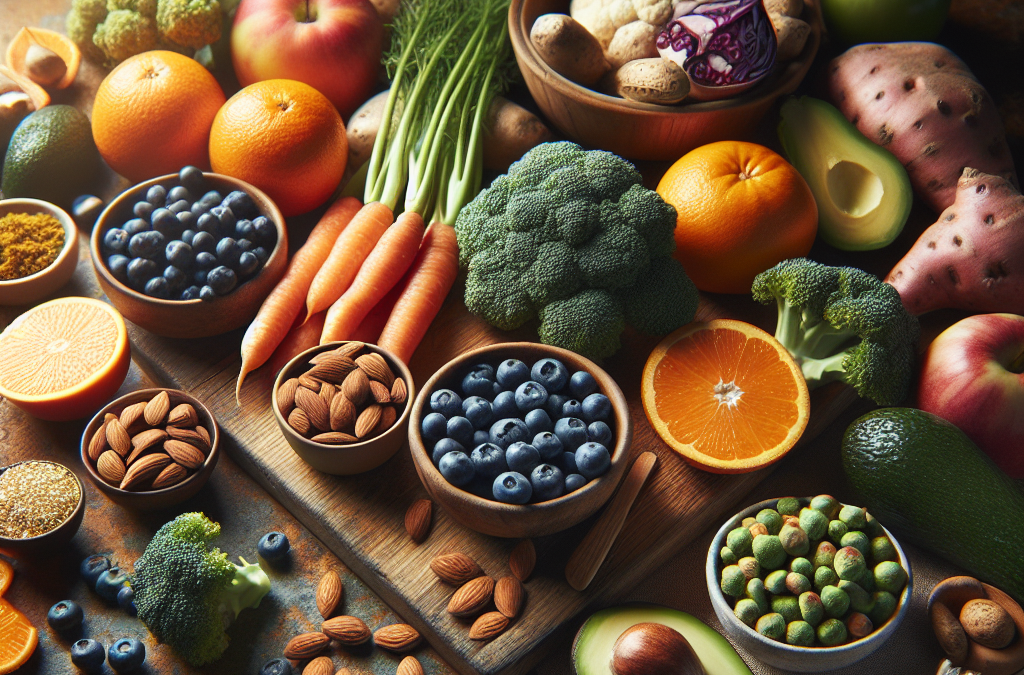- 1. Berries: Natureâs Antioxidant Powerhouses
- 2. Leafy Greens for Nutrient Density
- 3. Cruciferous Vegetables and Cancer Prevention
- 4. Whole Grains for Energy and Digestive Health
- 5. Root Vegetables for Immunity and Vitality
- 6. Citrus Fruits for Vitamin C and Skin Health
- 7. Nuts and Seeds as Healthy Snack Options
- 8. Fermented Foods for Gut Health
- 9. Legumes for Plant-Based Protein
- 10. Fresh Herbs and Spices for Flavour and Health
1. Berries: Natureâs Antioxidant Powerhouses
Rich in Nutrients and Antioxidants
Berries such as blueberries, strawberries, and raspberries are among the top fresh whole foods to eat in 2025 for their impressive antioxidant content. These tiny fruits are packed with vitamins, minerals, and phytochemicals that combat oxidative stress and inflammation, which are linked to chronic diseases like heart disease and diabetes.
Studies show that regular consumption of berries can improve cardiovascular health, cognitive function, and even aid weight management. Their high levels of vitamin C and anthocyanins have been linked to better immune function and reduced risk of certain cancers.
If you’re looking to incorporate more berries into your diet, consider adding them to your breakfast oatmeal, smoothies, or as a healthy snack. Buying organic and locally sourced berries can maximize their nutrient content in 2025.
Practical Tips for Incorporating Berries
Fresh berries are versatile and easy to include in daily meals. Wash thoroughly and add to yogurt, salads, or desserts. Frozen berries are also a convenient alternative when fresh are out of season, maintaining most of their nutritional benefits.
Remember, portion control is key as berries contain natural sugars, but their fiber content helps offset blood sugar spikes. Aim for at least 1 cup of berries daily for optimal health benefits.
2. Leafy Greens for Nutrient Density
Colors and Nutritional Benefits
Leafy greens like kale, spinach, and Swiss chard are among the best fresh whole foods to eat due to their dense nutrient profile. They are rich in vitamins A, C, K, folate, and minerals like iron and calcium, essential for overall health and vitality in 2025.
Eating more leafy greens is associated with lower inflammation and a reduced risk of chronic illnesses such as heart disease and osteoporosis. Their high fiber content also supports gut health and digestive regularity.
Including a variety of greens in your diet can be as simple as salads, wraps, or stirred into soups. Organic and locally harvested greens tend to retain higher nutrients, making them a top choice in 2025.
Tips for Maximizing Green Intake
To maximize nutrient absorption, gently massage tougher greens like kale with lemon juice or olive oil before eating. Experiment with smoothies, which are an easy way to consume multiple servings daily.
Buy seasonal greens from local farmersâ markets to ensure freshness and flavor. Keep greens refrigerated in breathable bags to preserve their crispness and nutrients.
3. Cruciferous Vegetables and Cancer Prevention
Crucifers in the Spotlight
Cruciferous vegetables like broccoli, cauliflower, Brussels sprouts, and cabbage are some of the most effective fresh whole foods to eat for their cancer-fighting properties. They contain sulfur compounds called glucosinolates, which have been linked to detoxification and decreased oxidative damage.
Research indicates that regular intake of crucifers can lower the risk of cancers, including colon, lung, and breast cancer. Their high fiber and phytochemical content also support digestive health and reduce inflammation.
In 2025, aim to incorporate cruciferous vegetables into your weekly meal plan through roasting, steaming, or raw salads for maximum health benefits.
Creative Serving Ideas
Try roasting broccoli with garlic and olive oil or adding shredded raw cabbage into salads and wraps. Stir-frying Brussels sprouts with a splash of soy sauce can be a delicious side dish. For variety, include different crucifers to benefit from a broad spectrum of nutrients.
Choose organic options where possible to avoid pesticides, which can be higher on non-organic cruciferous vegetables. Regular consumption supports immune function and disease prevention efforts in 2025.
4. Whole Grains for Energy and Digestive Health
Essential Carbohydrates and Fiber
Whole grains such as oats, quinoa, brown rice, and barley remain some of the most effective fresh whole foods to eat for sustained energy and digestive health in 2025. Unlike refined grains, they retain bran and germ, providing fiber, vitamins, and minerals essential for nutrient absorption and regular bowel movements.
Eating whole grains can help stabilize blood sugar levels, support weight management, and reduce the risk of type 2 diabetes. Their diverse flavors and textures make them a versatile staple in meals like salads, bowls, and side dishes.
Studies also link whole grain consumption with a reduced risk of cardiovascular disease, making them a must in your 2025 diet plan.
Tips for Incorporation
Switch to whole grain varieties of bread, pasta, and rice. Start your day with oatmeal topped with nuts and fruit for added nutrients. Experiment with ancient grains like millet or freekeh for variety.
Buy in bulk to ensure freshness and reduce packaging waste. Proper storage in airtight containers helps maintain original flavor and nutrient quality over time.
5. Root Vegetables for Immunity and Vitality
Nourishing Benefits of Roots
Carrots, beets, sweet potatoes, and turnips are among the best fresh whole foods to eat in 2025 for boosting immunity and vitality. Their vibrant colors signal high levels of antioxidants like beta-carotene and anthocyanins, which support skin, eye health, and immune function.
Root vegetables are hearty, nutrient-dense, and can be roasted, mashed, or added to stews for nutrient preservation and flavor. Their complex carbohydrates provide sustained energy throughout the day.
In addition, beets contain nitrates that may enhance blood flow and exercise performance, making them a valuable addition to active lifestyles in 2025.
Practical Tips for Consumption
Incorporate root vegetables into soups and roasted vegetable platters. Experiment with pickled beets or sweet potato fries as healthier snack choices. Buying seasonal, organic roots from local sources ensures freshness and maximum nutrient retention.
Store root vegetables in a cool, dark place to keep them fresh longer. Regularly include them in your diet to support overall health and energy levels in 2025.
6. Citrus Fruits for Vitamin C and Skin Health
Vital for Immune Function
Citrus fruits like oranges, grapefruits, lemons, and limes are prized for their high vitamin C content, making them key fresh whole foods to eat in 2025 to boost immunity. Vitamin C is crucial for collagen synthesis, skin elasticity, and fighting off common colds and infections.
Fresh citrus also provides fiber, antioxidants, and phytochemicals that support overall health. Their refreshing flavor makes them an easy addition to salads, beverages, or eaten on their own.
Recent studies in 2025 suggest that higher citrus intake correlates with decreased inflammation markers and improved skin health, reinforcing their importance in a balanced diet.
Huge Discount on the Best Certified Organic Whole Food Supplement!
Serving Suggestions and Tips
Squeeze fresh lemon or lime juice over salads or grilled dishes to enhance flavor and vitamin C intake. Snack on whole oranges or grapefruit segments for a portable, healthful treat. Try adding citrus zest to baked goods for an extra nutritional boost.
Opt for organic, locally grown citrus during peak season to maximize flavor and nutrients in 2025.
7. Nuts and Seeds as Healthy Snack Options
Nutritional Powerhouses
Almonds, walnuts, chia seeds, flaxseeds, and hemp seeds are excellent fresh whole foods to eat for healthy fats, protein, and fiber. These nutrient-dense snacks support brain health, heart health, and weight management in 2025.
Research shows that regularly consuming nuts and seeds can lower LDL cholesterol and reduce inflammation. Their healthy monounsaturated and polyunsaturated fats are essential for hormone production and cell function.
Adding a handful of nuts or seeds to your meals or snacks provides a convenient way to boost nutrition on busy days.
Tips for Incorporating Nuts and Seeds
Sprinkle seeds on yogurt, cereal, or salads. Roast nuts with herbs and spices for a flavorful snack. Keep portions moderateâabout a small handfulâto avoid excess calorie intake.
Buy raw and organic when possible. Store in airtight containers in cool, dark places to maintain freshness and nutrient integrity in 2025.
8. Fermented Foods for Gut Health
Probiotic-Rich Choices
Kefir, sauerkraut, kimchi, and yogurt are among the best fresh whole foods to eat in 2025 that promote a healthy gut microbiome. Fermented foods contain beneficial probiotics that enhance digestion, strengthen immune responses, and support mental health.
Growing evidence in 2025 highlights the connection between gut health and overall well-being, making fermented foods an essential part of a balanced diet.
Including fermented foods regularly can improve nutrient absorption and reduce digestive discomfort.
Practical Advice for Adding Fermented Foods
Start your day with a serving of yogurt or kefir. Add sauerkraut or kimchi as a side dish or topping for sandwiches and bowls. Make your own at home with simple fermentation kits to ensure freshness and control over ingredients.
Opt for unpasteurized, raw versions to preserve probiotic content. Incorporate a variety of fermented foods into weekly meals for optimal gut health in 2025.
9. Legumes for Plant-Based Protein
Benefits and Nutritional Content
Legumes such as lentils, chickpeas, black beans, and kidney beans are some of the most effective fresh whole foods to eat for plant-based protein and fiber in 2025. They support muscle health, weight management, and stable blood sugar levels.
Research supports their role in reducing the risk of cardiovascular diseases and type 2 diabetes. Legumes are also budget-friendly and versatile, fitting many cuisines worldwide.
Adding legumes to salads, soups, or making hummus are easy ways to incorporate them into your diet in 2025.
Preparation Tips
Soak and cook dried legumes to reduce antinutrients and improve digestibility. Use canned options for convenience, just rinse thoroughly to remove excess sodium.
Experiment with different spices and flavorings to enhance their taste. Incorporating legumes regularly supports a balanced, protein-rich diet in 2025.
10. Fresh Herbs and Spices for Flavour and Health
Adding Flavour with Nutritional Benefits
Fresh herbs like parsley, cilantro, basil, and mint are powerful flavor enhancers and contain antioxidants, vitamins, and anti-inflammatory compounds. Spices such as turmeric, ginger, and cinnamon are among the top fresh whole foods to eat for their medicinal properties in 2025.
Using herbs and spices can reduce the need for salt or sugar, supporting heart health and blood sugar control.
Including a variety of herbs and spices in your meals enriches both taste and nutritional profile, making your diet more enjoyable and health-boosting in 2025.
Practical Tips for Usage
Add chopped herbs to salads, soups, and stir-fries. Infuse oils or teas with spices for added health benefits. Grow your own herbs at home for freshness and sustainability.
Practice mindful seasoning to reap maximum health benefits without overdoing it. Fresh herbs and spices are an excellent way to elevate your meals naturally in 2025.
Conclusion
Prioritizing the most effective fresh whole foods to eat in 2025 can have a profound impact on your health. Incorporating a variety of berries, greens, cruciferous vegetables, whole grains, roots, citrus, nuts, fermented foods, legumes, and herbs ensures your body gets essential nutrients, antioxidants, and probiotics. Making these foods a regular part of your diet supports immune health, vitality, and disease prevention, helping you thrive in 2025 and beyond.
Frequently Asked Questions about Fresh Whole Foods to Eat
1. Why are fresh whole foods to eat important for health in 2025?
Fresh whole foods provide essential nutrients without added preservatives or processing, supporting optimal health, immune function, and disease prevention in 2025.
2. How can I incorporate more fresh whole foods to eat into my daily diet?
Plan balanced meals with fruits, vegetables, whole grains, nuts, and legumes. Prepare simple recipes like salads, smoothies, and roasted veggies to make healthy eating easy and enjoyable.
3. What are the best seasonal fresh whole foods to focus on in 2025?
Focus on berries in summer, leafy greens in spring, root vegetables in fall, and citrus fruits in winter for maximum flavor and nutrient value.
4. Are organic fresh whole foods to eat better than non-organic options?
Generally, organic options are free from synthetic pesticides and may retain more nutrients, making them preferable when available. In 2025, choose organic especially for berries, greens, and roots.
5. Can fresh whole foods to eat help with specific health concerns?
Yes, these foods support immunity, digestion, heart health, and can even reduce the risk of chronic illnesses when included regularly in a balanced diet.




